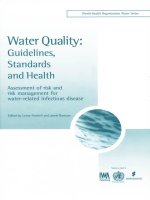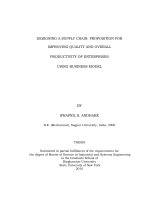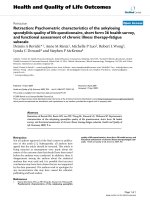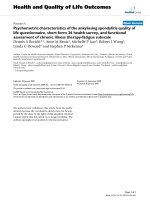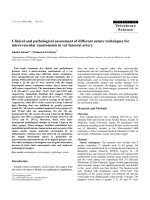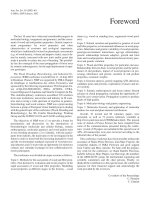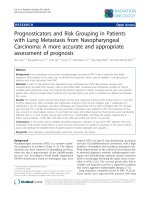Quality and safety assessment of sexual performance enhancement herbal medicines
Bạn đang xem bản rút gọn của tài liệu. Xem và tải ngay bản đầy đủ của tài liệu tại đây (1.09 MB, 186 trang )
QUALITY AND SAFETY ASSESSMENT OF SEXUAL
PERFORMANCE ENHANCEMENT
HERBAL MEDICINES
LOW MIN YONG
(B.Sc (Hons), NUS)
A THESIS SUBMITTED
FOR THE DEGREE OF MASTER OF SCIENCE
DEPARTMENT OF PHARMACY
NATIONAL UNIVERSITY OF SINGAPORE
2011
ACKNOWLEDGEMENTS
This dissertation would not have been possible without the guidance and the help
of several individuals who in one way or another contributed and extended their
valuable assistance in the preparation and completion of this work.
First and foremost, I offer my sincerest gratitude to my supervisor, Associate
Professor Koh Hwee Ling (Department of Pharmacy, NUS), who has supported
me throughout my thesis with her patience and knowledge whilst allowing me the
room to work in my own way. I attribute the level of my masters degree to her
encouragement and effort and without her, this thesis would not have been
completed or written.
Besides my supervisor, my heartfelt thanks go to Dr Zeng Yun (Health Sciences
Authority), Mr Li Lin (Department of Pharmacy, NUS), Dr Ge Xiaowei (Health
Sciences Authority) and Dr Kee Chee Leong (Health Sciences Authority) for their
support, guidance and valuable assistance in this work. I would also like to
acknowledge the Health Sciences Authority for the award of a sponsorship for
this study.
Last but not least, I would also like to express my warmest thanks to my family
members for their encouragement and understanding throughout these years.
I
LIST OF PUBLICATIONS
1.
Li L, Low MY, Aliwarga F, Teo J, Ge XW, Zeng Y, Bloodworth BC, Koh
HL. 2009a. Isolation and identification of hydroxythiohomosildenafil in
herbal dietary supplements sold as sexual performance enhancement
products. Food Addit Contam Part A Chem Anal Control Expo Risk
Assess 26: 145-151.
2.
Li L, Low MY, Ge X, Bloodworth BC, Koh HL. 2009b. Isolation and
structural elucidation of dapoxetine as an adulterant in a health supplement
used for sexual performance enhancement. J Pharm Biomed Anal 50: 724728.
3.
Low MY, Zeng Y, Li L, Ge XW, Lee R, bloodworth BC, Koh HL. 2009.
Safety and quality assessment of 175 illegal sexual enhancement products
seized in red-light districts in Singapore. Drug Saf 32: 1141-1146.
4.
Häberli A, Girard P, Low MY, Ge X. 2010. Isolation and structural
elucidation of an interaction product of aminotadalfil found in an illegal
health product. J Pharm Biomed Anal 53: 24-28.
5.
Low MY, Li L, Ge X, Kee CL, Koh HL. 2011. Isolation and structural
elucidation of Flibanserin as an adulterant in a health supplement used for
female sexual performance enhancement. J Pharm Biomed Anal
(Submitted).
II
LIST OF POSTER PRESENTATIONS
1.
Li L, Low MY, Ge X, Bloodworth BC, Koh HL. Metabolomic profiling of
three Panax species using pressurized liquid extraction and LC-LTQOrbitrap XL FTMS. Poster presentation, Recent Development in Chinese
Herbal Medicine Conference, 25-26 Jan 2010, Nanyang Technological
University, Singapore (Best poster award).
2.
Li L, Low MY, Aliwarga F, Teo J, Ge X, Zeng Y, Bloodworth BC, Koh
HL. Identification of a sildenafil analogue in an internet health supplement.
22nd Federation of Asian Pharmaceutical Association Congress (FAPA
2008), 7-10 Nov 2008, Grand Copthorne Waterfront Hotel, Singapore.
3.
Li L, Low MY, Ge X, Bloodworth BC, Koh HL. Metabolomic profiling of
three Panax species using pressurized liquid extraction and LC-LTQOrbitrap XL FTMS. Poster presentation, Educating Pharmacists (Asia)
Symposium, 15-16 Apr 2010, National University of Singapore,
Singapore.
4.
Li L, Low MY, Ge XW, Bloodworth BC, Koh HL. Metabolomic profiling
of three Panax species using pressurized liquid extraction and LC-LTQOrbitrap XL FTMS. Poster presentation, 6th AAPS-NUS Student Chapter
(ANSC) Scientific Symposium, 7 Apr 2010, National University of
Singapore, Singapore.
III
5.
Ng C, Li L, Ge X, Low MY, Koh HL. Authentication of herbs by plants
metabolomics. 5th AAPS-NUS Student Chapter (ANSC) Scientific
Symposium, 1 Apr 2009, National University of Singapore, Singapore.
IV
LIST OF ABBREVIATIONS
a.k.a
also know as
ADR
Adverse Drug Reaction
ANH-Intl
Alliance for Natural Health International
BP
British Pharmacopoeia
CE
Collision Energy
CP
Chinese Pharmacopoeia
CPM
Chinese Proprietary Medicines
CSM
Committee on Safety of Medicines, UK
CXP
Collision Cell Exit Potential
DAD
Diode Array Detection
DP
Declustering Potential
DSHEA
Dietary Supplement Health and Education Act, USA
EBF
European Benefyt Foundation
EHPA
European Herbal Practitioners Association
EMA
European Medicines Agency
EP
Entrance Potential
EPI
Enhanced Product Ion
ESI
Electrospray Ionization
FTMS
Fourier Transform Mass Spectrometry
GACP
Good Agricultural and Collection Practices
GMP
Good Manufacturing Practices
V
GC
Gas Chromatography
HKSAR
Hong Kong Special Administrative Region
HM
Herbal medicines
HMPC
Herbal Medicinal Products Committee formed under EMA
HSA
Health Sciences Authority, Singapore
HPLC
High Performance Liquid Chromatography
HSDD
Hypoactive Sexual Desire Disorder
ICP
Inductively Coupled Plasma
IDA
Information-dependent Acquisition
IMS
Ion Mobility Spectrometry
IR
Infrared Spectrometry
LC
Liquid Chromatography
LTQ
Quadrupole Linear Ion
MS/MS
Tandem Mass Spectrometry
LOD
Limit of Detection
MRM
Multiple reaction monitoring
MS
Mass Spectrometry
NAION
Nonarteritic Anterior Ischemic Optic Neuropathy
NMR
Nuclear Magnetic Resonance Spectroscopy
OTC
Over-The-Counter
PDE-5
Phosphodiesterase Type 5 enzyme
Q1
First Quadrupole
VI
Q2
Third Quadrupole
RT
Retention Time
THMP
Traditional Herbal Medicinal Products
TM
Traditional Medicines
TCM
Traditional Chinese Medicine
USP
US Pharmacopoeia
WHO
World Health Organization
VII
TABLE OF CONTENTS
ACKNOWLEDGEMENTS
I
LIST OF PUBLICATIONS
II
LIST OF POSTER PRESENTATIONS
III
LIST OF ABBREVIATIONS
V
TABLE OF CONTENTS
VIII
SUMMARY
XII
LIST OF TABLES
XV
LIST OF FIGURES
XVI
Chapter 1 Introduction
1.1
1.2
Quality and safety of herbal medicines
1
1.1.1
2
Plant misidentification and substitution
1.1.2 Plant toxicity
4
1.1.3
Interactions with conventional drugs
6
1.1.4
Standardization
8
1.1.5
Contamination
10
1.1.6
Adulteration
11
1.1.7
ADRs reporting
13
Regulatory environment for herbal medicines
15
1.2.1 Regulatory control of herbal medicines in USA
16
1.2.2 Regulatory control of herbal medicines in Europe
19
VIII
1.3
1.2.3 Regulatory control of herbal medicines in China
22
1.2.4
24
Regulations for herbal medicines in Singapore
An emerging threat : adulteration of herbal medicines with PDE-5
Inhibitors and their related analogues
Chapter 2 Rationale and Objective
27
39
Chapter 3 Safety and quality assessment of 247 illegal sexual enhancement
products seized by Health Sciences Authority
3.1 Introduction
42
3.2
Objective
44
3.3
Experimental
44
3.3.1 Materials
44
3.3.2 Samples and standards preparation
45
3.3.3 Screening by HPLC-DAD
46
3.3.4 Screening by GC-MS
47
3.3.5 Confirmation by LC-ESI-MS/MS
48
3.3.6 Quantification by HPLC-DAD and LC-MS-MS
49
3.4 Result and discussion
3.4.1
3.5
50
Safety assessment
50
3.4.2 Product labels and claims
51
3.4.3 Discussion
53
Conclusion
57
IX
Chapter 4 Screening of PDE-5 Inhibitors and their analogues in sexual
performance enhancement health products by Liquid
Chromatograph Hybrid Tandem Mass Spectrometer
4.1 Introduction
59
4.2 Objective
61
4.3 Experimental
62
4.3.1
Materials
62
4.3.2
Sample preparation for validation
62
4.3.3
Instrumentation and chromatographic conditions for screening
test
63
4.3.4
MS/MS Library
65
4.3.5
Confirmation of adulterants
65
4.4 Results and discussion
77
4.5 Conclusion
85
Chapter 5 Isolation and structural elucidation of Flibanserin as an adulterant
in a health supplement used for female sexual performance
enhancement
5.1 Introduction
86
5.2 Objective
88
5.3 Experimental
88
5.3.1
Sample and chemicals
88
X
5.3.2
Extraction of sample
89
5.3.3
Preparative HPLC
89
5.3.4
LC-DAD analysis
90
5.3.5
LTQ Orbitrap XL FTMS analysis
90
5.3.6
NMR and IR analyses
91
5.4 Results and discussion
91
5.5 Conclusion
110
Chapter 6 Conclusion
111
BIBLIOGRAPHY
115
APPENDIX I
140
XI
SUMMARY
In recent years, there is increasing interest in the use of herbal health products as
an alternative to erectile dysfunction drugs to enhance sexual performance.
Adverse events associated with the consumption of herbal products for sexual
performance enhancement and treatment of erectile dysfunction have been
reported. In Singapore, four illegal sexual performance enhancement health
products have been reported to be adulterated with sildenafil and a very high dose
of glibenclamide. These products have caused severe hypoglycaemia leading to
10 deaths in Singapore.
The objectives of this study are to assess the safety and quality of sexual
performance enhancement herbal health products illegally sold in the red-light
districts in Singapore and to develop analytical methods to enhance the adulterant
testing capability in a national quality control laboratory.
The first part of the study assessed the safety and quality of the sexual
performance enhancement herbal products in Singapore. This part of the work
involved adulterant screening of 247 illegal sexual enhancement health products
seized by Health Sciences Authority (HSA) during the period Feb to Dec 2008
from makeshift stalls in red-light districts of Singapore and a shipment at the
Singapore Customs. The extent of adulteration, contamination and content level
of the adulterants were assessed. The risks associated with the consumption of
XII
such products were also evaluated. The extensive list of adulterated products
tested and the assessment results will be useful to consumers, regulators and the
industry players.
The second part of the project involved the development of a LC-Hybrid Tandem
MS method for the detection of PDE-5 inhibitors and their related analogues in
herbal health products marketed for sexual performance enhancement. The
method developed was able to screen for the 3 approved PDE-5 inhibitor drugs
(Sildenafil, Tadalafil and Vardenafil) and their related 22 analogues in sexual
enhancement health products in 20 min. The developed screening method was
validated using 11 blinded samples (consisting positive and negative products
previously tested by HSA’s laboratory) and the validation results showed that the
screening method was rapid, sensitive, specific and was able to simultaneously
detect the PDE-5 inhibitors and related analogues present in the samples. To the
best of our knowledge, this is thus far the only method that can provide such
comprehensive screening of the PDE-5 inhibitors and their related analogues.
The final part of the project involved the structural elucidation of an unknown
adulterant detected in a herbal health product claimed for female sexual
performance enhancement. The product was sent by a client to HSA for testing.
The chemical structure of the unknown compound with molecular mass of 390
was structurally elucidated using LC-DAD, LC-LTQ Orbitrap XL FTMS, NMR
and IR analysis. The unknown adulterant was confirmed to be flibanserin, a non-
XIII
hormonal treatment drug developed for pre-menopausal woman with hypoactive
sexual desire disorder (HSDD). The New Drug application for flibanserin was
rejected by FDA Advisory Committee for Reproductive Health Drugs as the
efficacy was deemed not sufficiently robust to justify the risks, concerns over the
safety signals and potential drug interactions. The results of this study enabled the
local regulator to stop the adulterated health product from entering Singapore’s
market and raised the awareness of the possible adulteration of flibanserin in
health products claimed for female sexual performance enhancement.
The work presented in this thesis is useful to consumers, regulators, health care
professionals and industry players. The method developed and validated has
helped to enhance the testing capability of the national regulatory control
laboratory in screening and detection of PDE-5 inhibitors, their analogues and
other unknown adulterants found in health products claimed for sexual
performance enhancement.
XIV
LIST OF TABLES
Table 1.1
Undeclared synthetic drugs found in herbal products to treat sexual
dysfunction or to enhance sexual performance (2002 – 2011)
Table 4.1
Details on the eleven blind samples for validation study
Table 4.2
MRM transitions, infusion data and LOD for PDE-5 inhibitors and
their related analogues
Table 4.3
Validation results for the LC-Hybrid Tandem MS Screening
System
Table 5.1
NMR data for unknown compound
XV
LIST OF FIGURES
Figure 3.1
Number of times (with percentage) that each adulterant was
detected in the 190 samples that were found to be adulterated with
western drugs. Some samples contained more than one adulterant
Figure 3.2
Levels of sildenafil detected per dosage unit in the 165 products
that were found to be adulterated with sildenafil
Figure 4.1
Analytical procedure for MS/MS screening
Figure 4.2
Total
ion
chromatogram:
validation
sample
number
6,
aminotadalafil at 7.29 min
Figure 4.3
Library search results for validation sample number 6 - acquired
analyte spectra and library spectra at CE (a) 20 eV, (b) 35 eV and
(c) 50 eV showing purity match from library search at 3 different
CE
Figure 5.1
UV-vis spectrum of unknown compound in methanol, scanned
from 200 nm to 400 nm, showing the maximal absorbances at 210
nm, 230nm, 250 nm and 280 nm
Figure 5.2
HPLC chromatograms of (A) methanol extract of MMP and (B)
purified unknown compound at wavelength 254 nm
Figure 5.3
High resolution MS spectrum of unknown compound
Figure 5.4
High resolution ESI MS/MS spectrum of unknown compound
Figure 5.5
Proposed chemical structure of unknown compound
XVI
Figure 5.6
Proposed ESI-MS/MS fragmentation of the protonated molecules
of unknown compound ([M+H]+ m/z 391.17310)
Figure 5.7
1
H-NMR spectrum of unknown compound in deuterated
chloroform
Figure 5.8
13
C-NMR spectrum of unknown compound in deuterated
chloroform
Figure 5.9
DEPT spectrum of unknown compound in deuterated chloroform
Figure 5.10
HMQC spectrum of unknown compound in deuterated chloroform
Figure 5.11
HMBC spectrum of unknown compound in deuterated chloroform
Figure 5.12
1
H-1H COSY spectrum of unknown compound in deuterated
chloroform
Figure 5.13
FTIR spectrum of unknown compound
XVII
Chapter 1
Introduction
1.1
Quality and safety of herbal medicines
Herbal medicines are plant-derived materials or preparations with therapeutic or
other health benefits, containing either raw or processed ingredients from one or
more plants (Barnes 2003a, WHO 2005). Herbal supplements are a form of herbal
medicines.
Herbal medicines are widely used around the world. About 1.5 billion people
worldwide use traditional Chinese herbal medicines (Hosbach et al. 2003). A
survey conducted in 2005 (Jordan et al. 2010) revealed that 71% of Canadian used
natural health products, which include herbal medicines, vitamins and minerals.
11% of the people surveyed used herbal remedies and algal/fungal products. In
the United States, about 19% of the adult population was using herbal medicines
as of 2002 (Jordan et al. 2010, Kennedy 2005). Another study showed that about
$17.8 billion was spent in the U.S. on dietary supplements with $4.2 billion of this
amount on herbs (Dobos et al. 2005, NBJ 2002).
Although herbal medicines are widely considered to be of lower risk compared to
synthetic drugs, they are not completely free from the possibility of toxicity or
other adverse effects (De Smet 2004). While inherent toxicity of certain herbs
1
such as Ephedra and Aristolochia is well known, adverse effects from the use of
herbal medicines may also result from contamination of products with toxic
metals,
adulteration
with
pharmacologically
active
synthetic
drugs,
misidentification or substitution of herbal ingredients, or improperly processed
products. Interactions may also occur between drugs, food and other herbal
medicines taken concomitantly (Jordan et al. 2010).
The following sections
discuss various quality and safety issues related to herbal medicines.
1.1.1 Plant misidentification and substitution
The correct identification of plant materials during collection and processing is
critical for the quality control of herbal medicines. Substitution with more toxic
herbs may occur due to misidentification of plant species or deliberately for
economic reasons when a cheaper herb is supplied to replace a safe, more
expensive one. Several cases of incorrect plant substitution or mis-identification
have been reported. One example which resulted in significant morbidity, in
particular, renal failure and renal cancer following the use of slimming products
contaminated with Aristolochia species first surfaced in the 1990s, initially from
Belgium, France and later UK (Barnes et al. 2002, EMEA 2002, Jordan et al.
2010). This was due to the substitution of nontoxic herbs, including Stephania
tetrandra and Clematis armandii, with toxic Aristolochia species.
2
Koren et al. reported a case of maternal and neonatal androgenisation associated
with a herbal product in 1990. The mother experienced increased hair growth on
her head, forehead and public area. At birth, the male child had thick hair in the
pubic region, and on the forehead, along with red swollen nipples. The mother
had been taking a commercial product labeled as containing “Siberian ginseng”
during her pregnancy and 2 weeks of breast feeding (Koren et al. 1990). Awang
later investigated the case and found that the raw materials used did not contain
authentic Siberian ginseng (Eleutherococcus senticosus (Rupr. And Maxim.)
Maxim.), but were likely to contain silk vine (Periploca sepium Bunge,
Apocynaceae) instead. It had previously been known that some Periploca species
had been substituted for Eleutherococcus in some imported products, possibly due
to confusion of the Chinese names of the two plants (Awang 1991, Jordan et al.
2010). The Chinese name for Eleutherococcus senticosus is “Ci-wu-jia” (刺 五
加), while the Chinese name for Periploca sepium is “wu-jia” (五 加), which may
explain the source of confusion (Boon and Smith 2004).
A similar case was reported in 2004. A 60-year-old man was diagnosed with
kidney failure and cancer of the urinary tract in Hong Kong (Zhao et al. 2006,
Liang et al. 2006). He had been taking a herbal prescription called “Bai Mao
Teng” (白毛藤). Investigation by HKSAR Department of Health revealed that the
patient had been mistakenly given Aristolochia mollissima Hance (Xun Gu Feng,
寻 骨 风). Aristolochia mollissima Hance is known to contain aristolochic acid.
Further investigation revealed that Aristolochia mollissima Hance was
3
erroneously substituted for Solanum lyratum Thunb (Bai Ying, 白 英) at the
wholesale level as both the crude drugs have the same common names “Bai Mao
Teng” (白毛藤). It was also found that there is recurring confusion with regard to
the names Xun Gu Feng, Bai Ying and Bai Mao Teng. In light of this, the
HKSAR Department of Health called for a suspension of the use of these 3
Chinese herbs (Liang et al. 2006).
1.1.2 Plant toxicity
There is a common misconception that because herbs are natural, they are entirely
‘safe’. Clearly, this is not the case (some plants are inherently poisonous), and
plants used medicinally do, in some cases, cause adverse effects. Paracelsus,
sometimes called the Father of Toxicology, had also in his famous quote, “Poison
is in everything, and nothing is without poison; only the dose permits something
not to be poisonous” said that substances considered toxic are harmless in small
doses, and conversely an ordinarily harmless substance can be deadly if overconsumed. This applies to the toxicity of herbal medicines. In general, little is
known regarding the adverse effect of most herbal medicines.
Digitalis species, Rauvolfia serpentine (L.) Benth. ex Kurz. (Apocynaceae),
Atropa belladonna and Strychnos nux vomica L. (Strychnaceae), among others,
are toxic plants but they are useful therapeutic agents when used appropriately
and when administered in suitable doses. On the other hand, there are medicinal
4
plants that persistently evoke moderate to severe reactions, and should not be
employed in any medical therapy. Plants including species of Sebecio, Crotalaria,
and Symphytum, which contain pyrrolizidine alkaloids having an unsaturated 1,2double bond in the pyrrolizidine ring, should be avoided due to the hepatotoxic
effect of these compounds (Denham 1996, Fong 2002).
Aristolochia species are examples of plants containing toxic chemical constituents
that should not be used medically. Aristolochic acid I, found in all species of
Aristolochia investigated to-date, has been identified as a potent carcinogen and
nephrotoxin (Fong 2002, Menges and Stotzem 1993, Menges and Stotzem 1992,
Vanherweghem et al. 1993). Renal failure, nephritis, and urinary tract neoplasm
have been associated with the use of Chinese and Kampo herbal medicines that
contain Aristolocia species (Chen 2000, Fong 2002, Hashimoto et al. 1999,
Nortier et al. 2000, Vanherweghem et al. 1993).
In 2001, 30 cases of hepatotoxicity, ranging from abnormal liver function to liver
failure, associated with the use of kava extracts were reported in Germany and
Switzerland. One case was fatal and five others required liver transplants.
Although it is difficult to assess causality in these cases as the evidence is
complicated by other factors such as the use of concomitant drugs which may also
cause liver toxicity. However, by July 2002, the Medicines Control Agency
(MCA) in UK had received 68 case reports of hepatotoxicity worldwide,
including the UK (Barnes 2003b). The Committee on Safety of Medicines (CSM)
5
in UK revealed that the benefit-risk profile of kava appeared to be negative and on
13 January 2003, a statutory order came into effect in UK prohibiting the sale,
supply and import of unlicensed medicines containing kava (Barnes 2003b).
Singapore has also banned the sale of kava products.
1.1.3 Interactions with conventional drugs
In recent years, it has become increasingly clear that even therapeutically safe
herbs can manifest toxic effects as a result of herb-drug interaction, when
administered concomitantly with synthetic pharmaceutical agents. Since 1999,
evidence emerged of pharmacokinetic interactions between St John’s wort
(Hypericum perforatum) products and certain drugs, including anticancer agent
(imatinib and irinotecan), anti-HIV (e.g indinavir, lamivudine and nevirapine),
anti-inflammatory agents (e.g ibuprofen and fexofenadine), antimicrobial agents
(e.g erythromycin and voriconazole), cardiovascular drugs (e.g digoxin,
ivabradine, warfarin, verapamil, nifedipine and talinolol), central nervous system
agents (e.g amitriptyline, buspirone, phenytoin, methadone, midazolam,
alprazolam, and sertraline), hypoglycaemic agents (e.g tolbutamide and
gliclazide), immuno-modulating agents (e.g cyclosporine and tacrolimus), oral
contraceptives, proton pump inhibitor (omeprazole), respiratory system agent
(theophylline), statins (e.g atorvastatin and pravastatin) (Di et al. 2008, Zhou et al.
2004, Barnes et al. 2001a). Both pharmacokinetic and pharmacodynamic
components play a role in the interactions of drugs with St John’s wort (Di et al.
6
2008). As St John’s wort is a potent inducer of cytochrome P450s (e.g CYP2C9
and 3A4) and P-glycoprotein (P-gp), it is not surprise that many drugs that
interact with St John’s wort are substrates of CYP3A4, CYP2C9 and P-gp. The
combined use of St John’s wort with such drugs may enhance or reduce the
bioavailability of the drugs. Interactions leading to synergistic therapeutic effects
may lead to unfavorable toxicities and complicate the dosing regimen of longterm medications. Antagonistic interactions will result in decreased efficacy and
therapeutic failure (Di et al. 2008, Zhou et al. 2004).
Panax ginseng has been reported to interact with phenelzine and other
monoamine inhibitors causing central nervous system (CNS) stimulation (Chan
2003, Jones and Runikis 1987). The anticoagulant effect of warfarin was
decreased when Panax ginseng was also taken simultaneously (Chan 2003,
Janetzky and Morreale 1997). Digoxin levels were elevated in a patient who took
a preparation labeled as Siberian ginseng, Eleutherococcus senticosus, but there
was no sign of toxic effects (Chan 2003, McRae 1999). Danshen (Salvia
miltiorrhiza) affected both the pharmacodynamics and pharmacokinetics of
warfarin in rats (Chan 2003, Lo et al. 1992). Danshen prolonged the prothrombin
time of warfarin, an indicator of anti-coagulation in the rat (Lo et al. 1992) ;
increased the bioavailability and decreased the elimination of warfarin in the rat
(Chan et al. 1995) ; inhibited CYP1A1, CYP2C6 and CYP2C11-mediated
warfarin metabolism both in vitro and in vivo in the rats (Wu and Yeung 2010).
Danggui (Angelica sinensis) affected the pharmacodynamics but not the
7


